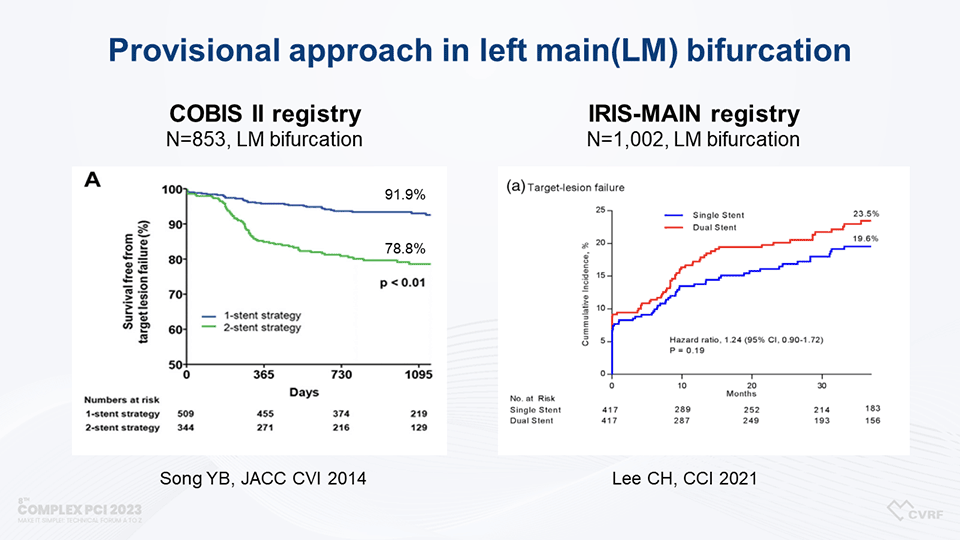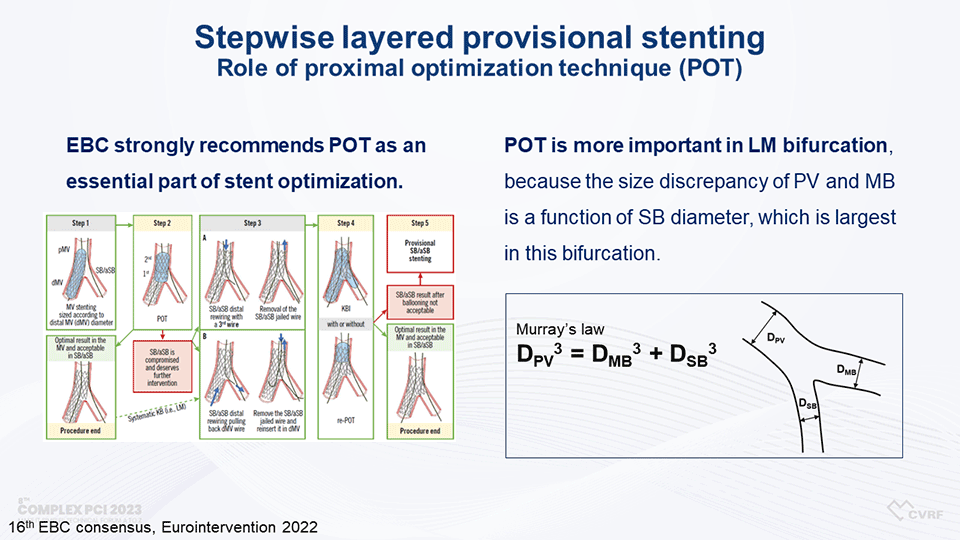News | COMPLEX PCI 2023
Be Provisional!
Optimal Provisional Strategy for LM PCI
Provisional stenting technique should be the preferred strategy for treating left main coronary bifurcation lesions
Dr. Hyeon-Cheol Gwon of the Heart Vascular Stroke Institute at Samsung Medical Center, Korea, began his presentation by examining the prevalence of the provisional approach in LM bifurcation, referencing the IRIS-MAIN and COBIS II registries. These registries revealed a high prevalence of the provisional approach, with respective rates of 91.9% and 78.8%, indicating its widespread acceptance in the medical community.


Hyeon-Cheol Gwon
Samsung Medical Center, Republic of Korea
Dr. Gwon further expanded on this by referencing various trials, including EBC Main and DK-CRUSH V. These trials compared the provisional approach with systematic two-stent strategies, highlighting that the simpler provisional approach yields outcomes comparable to the more complex two-stent strategies.
Building on this foundation, Dr. Gwon emphasized that stepwise layered provisional stenting is recommended as the preferred strategy for treating left main coronary bifurcation lesions. This approach, which balances efficacy with minimal invasiveness, is crucial for optimizing patient outcomes.
A key aspect of his presentation was the emphasis on the proximal optimization technique (POT) as an essential element in stenting optimization. Dr. Gwon stressed that POT is a critical step in ensuring the stent is optimally placed and expanded
to match the vessel's anatomy, which can significantly enhance the long-term success of the procedure.

Another important point Dr. Gwon made was regarding the treatment of the Left Circumflex (LCX) ostium. He noted that opening the LCX ostium does not show superior results compared to a simple crossover technique in a one-stent strategy, particularly in terms of long-term outcomes. This finding suggests that in many cases, a more conservative approach to LCX treatment might be preferable, avoiding unnecessary complexity in the stenting procedure.
Dr. Gwon's concluded that bifurcation lesions may be the only type of lesion that shows a better outcome when treated conservatively. This insight underscores the importance of a measured and thoughtful approach in interventional cardiology, particularly in the context of complex procedures like left main coronary bifurcation stenting.
Overall, Dr. Gwon's lecture provided a comprehensive view of the current strategies and data in treating left main coronary bifurcation lesions. His emphasis on a conservative, strategic approach, supported by substantial clinical data, presents a compelling argument for the provisional approach in interventional cardiology. These insights are poised to influence treatment strategies significantly, potentially leading to improved patient outcomes in complex coronary interventions.
Edited by

Ju Hyeon Kim, MD
Korea University Anam Hospital, Korea (Republic of)

KyungAe Kim, RN
CardioVascular Research Foundation (CVRF), Korea (Republic of)
Dr. Hyeon-Cheol Gwon of the Heart Vascular Stroke Institute at Samsung Medical Center, Korea, began his presentation by examining the prevalence of the provisional approach in LM bifurcation, referencing the IRIS-MAIN and COBIS II registries. These registries revealed a high prevalence of the provisional approach, with respective rates of 91.9% and 78.8%, indicating its widespread acceptance in the medical community.


Hyeon-Cheol Gwon
Samsung Medical Center, Republic of Korea
Dr. Gwon further expanded on this by referencing various trials, including EBC Main and DK-CRUSH V. These trials compared the provisional approach with systematic two-stent strategies, highlighting that the simpler provisional approach yields outcomes comparable to the more complex two-stent strategies.
Building on this foundation, Dr. Gwon emphasized that stepwise layered provisional stenting is recommended as the preferred strategy for treating left main coronary bifurcation lesions. This approach, which balances efficacy with minimal invasiveness, is crucial for optimizing patient outcomes.
A key aspect of his presentation was the emphasis on the proximal optimization technique (POT) as an essential element in stenting optimization. Dr. Gwon stressed that POT is a critical step in ensuring the stent is optimally placed and expanded
to match the vessel's anatomy, which can significantly enhance the long-term success of the procedure.

Another important point Dr. Gwon made was regarding the treatment of the Left Circumflex (LCX) ostium. He noted that opening the LCX ostium does not show superior results compared to a simple crossover technique in a one-stent strategy, particularly in terms of long-term outcomes. This finding suggests that in many cases, a more conservative approach to LCX treatment might be preferable, avoiding unnecessary complexity in the stenting procedure.
Dr. Gwon's concluded that bifurcation lesions may be the only type of lesion that shows a better outcome when treated conservatively. This insight underscores the importance of a measured and thoughtful approach in interventional cardiology, particularly in the context of complex procedures like left main coronary bifurcation stenting.
Overall, Dr. Gwon's lecture provided a comprehensive view of the current strategies and data in treating left main coronary bifurcation lesions. His emphasis on a conservative, strategic approach, supported by substantial clinical data, presents a compelling argument for the provisional approach in interventional cardiology. These insights are poised to influence treatment strategies significantly, potentially leading to improved patient outcomes in complex coronary interventions.
Edited by

Ju Hyeon Kim, MD
Korea University Anam Hospital, Korea (Republic of)

KyungAe Kim, RN
CardioVascular Research Foundation (CVRF), Korea (Republic of)

Leave a comment